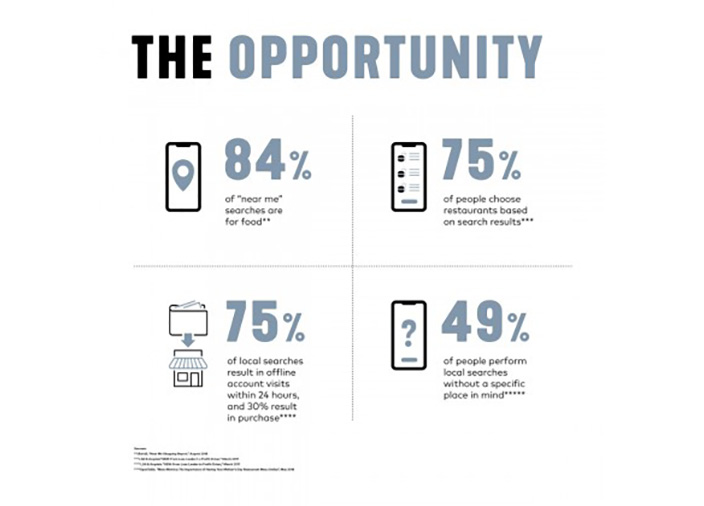To set your business up for success— to capture new and repeat business— your menu needs to be in all of these different places.
Put Your Menu Where People Are Looking For It
Profitable Menus
Guests Seek Your Menu Beyond Your Website

Guests Seek Your Menu Beyond Your Website
It’s Taco Tuesday. Your potential guests are online looking for tacos and a pitcher of to-go margaritas. They search out menus from all the nearby Mexican restaurants. Sure, they could end up browsing a menu on your restaurant’s website. More than likely, they will find your menu elsewhere. Like on a local Google My Business Directory. Or a menu hosting site like Allmenus. They could even be on a delivery app like UberEats or Grub Hub.
The reality is, menus are found in lots of different places. Your website is one.However, third-party sites are getting more popular every day. These include:
Local Business Directories
Menu Hosting Sites
Delivery Sites
To set your business up for success— to capture new and repeat business— your menu needs to be in all of these different places. Let’s dive deeper into the most important menu hosting locations and steps you can take to get your menu in front of guests.
A Guide to Third-Party Menu Hosting Sites
Local Business Directories
Local business directories are hosted on platforms like Google My Business, Yelp, Facebook and Trip Advisor. Listings on these directories often appear in the top spots when a guest performs a local search (ex. “cocktail bars near me”). They are critical for getting your business discovered. More than 70% of customers say they would be more likely to visit a restaurant with a My Google listing. To gain an edge, your business must set up a robust profile that provides guests with the information needed to choose your bar over others. Host your menu right on the directory wherever possible, or link to the menu on your bar’s website.
Menu Hosting Sites
You’ve probably heard of menu hosting sites like Allmenus and MenuPages. These sites act as a catch-all directory for restaurants to upload their menus. They also allow guests to leave reviews you can monitor and respond to in positive ways. Menu sites are often partnered with online delivery services, allowing customers to go from browsing and ordering seamlessly. Be sure to upload your full menu to these sites and make an effort to ensure accuracy and consistency.
Delivery Sites
If your venue uses a delivery service like Grubhub/Seamless, UberEats, Postmates or DoorDash, you will need to post your menu on their apps and websites. A menu hosted on a delivery site has different requirements and priorities than a menu hosted elsewhere. Each delivery site has its own requirements for menus. Be sure to check with each delivery partner on what you need to complete your business profile.
Regardless of where the menu lives, it should be streamlined, easy to navigate, and designed to upsell and encourage add-ons. Make sure to include a few enticing photos— remember, people order with their eyes first!
Your Website. A Worthy Investment.
While third-party sites are essential to digital menu success, your website has something no one else can provide. The best place to engineer a visually appealing, usable, profitable menu is your own website. It’s your look. It’s your brand. It’s the experience you create. This is your home base. On third-party sites, you play by their rules. This means using their templates and limiting your ability to follow menu engineering best practices.
Your menu is likely the most important page on your website— and the most visited. It’s critical that the menu is search-friendly, easy to navigate, and that it looks great on all devices. This is especially true on mobile, as this is where the majority of guests will be viewing it. You should do your best to utilize text-based menus and avoid PDFs (except as an option for downloading and printing).
Managing Your Menu in Multiple Places
With so many menu hosting sites, you may find different versions of your menu posted in different places. This can lead to a confusing and inconsistent experience for guests. Keeping up with it all can be time-consuming and complex. Good news— it doesn’t have to be. There are tools designed for “one and done” menu updates. They are called menu management systems. Simply make a change in the tool and it will automatically populate in all the places your menu lives online. This eliminates the possibility of a guest finding an outdated menu.
Reconsider Using PDF Menus
PDF format menus are popular. They’re relatively easy to create and post. However, PDF format menus do come with drawbacks that can be deal-breakers for guests.
Not Mobile Friendly: PDF images can be hard for mobile users to navigate, requiring a potential guest to pinch, zoom, and scroll to read menu items.
Space Is Limited: Including photographs, descriptions, and special items can be quite difficult.
Long Load Times + Quality: Depending on the file resolution size, PDFs also cause webpages to load more slowly, diminishing the user experience. On the contrary, if the file resolution is too low it can be blurry and hard to read.
Not Search Optimized: While PDFs can be picked up by search engines, they do not give the search engine everything it wants when analyzing and ranking pages. Unfortunately, this means your PDF menu may be preventing guests from finding you when they do a search.
